Spread of Mink SARS-CoV-2 Variants in Humans: A Model of Sarbecovirus Interspecies Evolution
- PMID: 34616371
- PMCID: PMC8488371
- DOI: 10.3389/fmicb.2021.675528
Spread of Mink SARS-CoV-2 Variants in Humans: A Model of Sarbecovirus Interspecies Evolution
Abstract
The rapid spread of SARS-CoV-2 variants has quickly spanned doubts and the fear about their ability escape vaccine protection. Some of these variants initially identified in caged were also found in humans. The claim that these variants exhibited lower susceptibility to antibody neutralization led to the slaughter of 17 million minks in Denmark. SARS-CoV-2 prevalence tests led to the discovery of infected farmed minks worldwide. In this study, we revisit the issue of the circulation of SARS-CoV-2 variants in minks as a model of sarbecovirus interspecies evolution by: (1) comparing human and mink angiotensin I converting enzyme 2 (ACE2) and neuropilin 1 (NRP-1) receptors; (2) comparing SARS-CoV-2 sequences from humans and minks; (3) analyzing the impact of mutations on the 3D structure of the spike protein; and (4) predicting linear epitope targets for immune response. Mink-selected SARS-CoV-2 variants carrying the Y453F/D614G mutations display an increased affinity for human ACE2 and can escape neutralization by one monoclonal antibody. However, they are unlikely to lose most of the major epitopes predicted to be targets for neutralizing antibodies. We discuss the consequences of these results for the rational use of SARS-CoV-2 vaccines.
Keywords: ACE2; COVID-19; COVID-19 vaccines; NRP-1; SARS-CoV-2; mink coronavirus; variant viruses.
Copyright © 2021 Devaux, Pinault, Delerce, Raoult, Levasseur and Frutos.
Conflict of interest statement
The authors declare that the research was conducted in the absence of any commercial or financial relationships that could be construed as a potential conflict of interest.
Figures



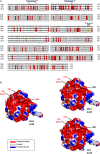
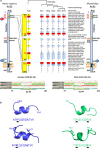
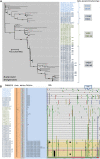
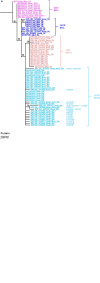
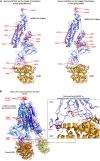
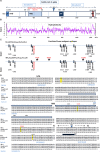
Similar articles
-
Role of spike compensatory mutations in the interspecies transmission of SARS-CoV-2.One Health. 2022 Dec;15:100429. doi: 10.1016/j.onehlt.2022.100429. Epub 2022 Aug 29. One Health. 2022. PMID: 36060458 Free PMC article.
-
Molecular Basis of Mink ACE2 Binding to SARS-CoV-2 and Its Mink-Derived Variants.J Virol. 2022 Sep 14;96(17):e0081422. doi: 10.1128/jvi.00814-22. Epub 2022 Aug 24. J Virol. 2022. PMID: 36000849 Free PMC article.
-
The SARS-CoV-2 Y453F mink variant displays a pronounced increase in ACE-2 affinity but does not challenge antibody neutralization.J Biol Chem. 2021 Jan-Jun;296:100536. doi: 10.1016/j.jbc.2021.100536. Epub 2021 Mar 11. J Biol Chem. 2021. PMID: 33716040 Free PMC article.
-
SARS-CoV-2 infection in farmed minks, associated zoonotic concerns, and importance of the One Health approach during the ongoing COVID-19 pandemic.Vet Q. 2021 Jan 1;41(1):50-60. doi: 10.1080/01652176.2020.1867776. Vet Q. 2021. PMID: 33349165 Free PMC article. Review.
-
The basis of mink susceptibility to SARS-CoV-2 infection.J Appl Genet. 2022 Sep;63(3):543-555. doi: 10.1007/s13353-022-00689-w. Epub 2022 Apr 9. J Appl Genet. 2022. PMID: 35396646 Free PMC article. Review.
Cited by
-
ACE2 receptor polymorphism in humans and animals increases the risk of the emergence of SARS-CoV-2 variants during repeated intra- and inter-species host-switching of the virus.Front Microbiol. 2023 Jul 13;14:1199561. doi: 10.3389/fmicb.2023.1199561. eCollection 2023. Front Microbiol. 2023. PMID: 37520374 Free PMC article.
-
Limited permissibility of ENL-R and Mv-1-Lu mink cell lines to SARS-CoV-2.Front Microbiol. 2022 Oct 12;13:1003824. doi: 10.3389/fmicb.2022.1003824. eCollection 2022. Front Microbiol. 2022. PMID: 36312916 Free PMC article.
-
The reverse zoonotic potential of SARS-CoV-2.Heliyon. 2024 Jun 13;10(12):e33040. doi: 10.1016/j.heliyon.2024.e33040. eCollection 2024 Jun 30. Heliyon. 2024. PMID: 38988520 Free PMC article. Review.
-
Endocytosis inhibitors block SARS-CoV-2 pseudoparticle infection of mink lung epithelium.Front Microbiol. 2023 Nov 14;14:1258975. doi: 10.3389/fmicb.2023.1258975. eCollection 2023. Front Microbiol. 2023. PMID: 38033586 Free PMC article.
-
Cats and SARS-CoV-2: A Scoping Review.Animals (Basel). 2022 May 30;12(11):1413. doi: 10.3390/ani12111413. Animals (Basel). 2022. PMID: 35681877 Free PMC article.
References
-
- Afelt A., Devaux C. A., Serra-Cobo J., Frutos R. (2018). Bats, bat-borne viruses, and environmental changes. IntechOpen chapter 8 113–131. 10.5772/intechopen.74377 - DOI
-
- Bazykin G. A. S., Danilenko D., Fadeev A., Komissarova K., Ivanova A., Sergeeva M., et al. (2021). Emergence of Y453F and D69-70HV Mutations In A Lymphoma Patient With Long-Term COVID-19.(2021). Available online at: https://virological.org/t/emergence-of-y453f-and-69-70hv-mutations-in-a-.... (accessed June 2021).
Publication types
LinkOut - more resources
Full Text Sources
Miscellaneous

